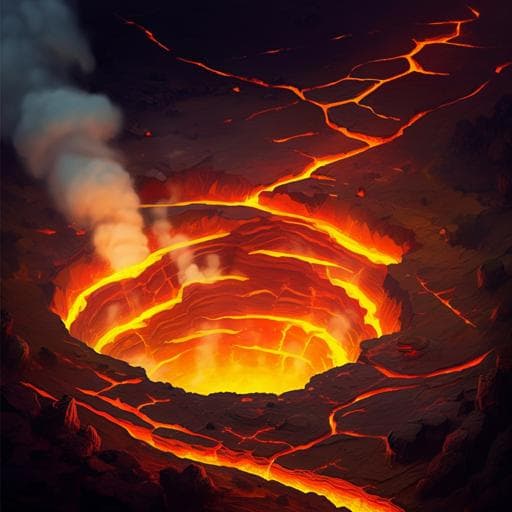
Earth Sciences
Hydrothermal fluid flow triggered by an earthquake in Iceland
L. Geoffroy, C. Dorbath, et al.
Discover how Laurent Geoffroy and his team explored microearthquake hypocenters in the Krýsuvík geothermal area of SW-Iceland. Their research reveals an intriguing bottom-to-top migration of seismicity, providing crucial insights into the interplay between tectonics and fluid flow in high-temperature hydrothermal systems.
~3 min • Beginner • English
Introduction
The study investigates how crustal fluids influence seismic and thermal energy release at divergent plate boundaries, focusing on the poorly understood coupling between crustal-scale fluid circulation and active fault tectonics. Prior conceptual models (e.g., fault-valve behavior) emphasize the role of pore pressure variations in the seismic cycle, and fluid-related processes have been invoked to explain aseismic displacements along normal faults. Hydrothermal convection is known to be critical to heat removal at spreading ridges, with distinct seismic swarms often associated with such systems. Similar swarm behavior is seen during deep borehole fluid injections, implicating pore-pressure diffusion in fractured media as a key process, possibly triggered by seismic events. In Icelandic hydrothermal systems, fluids are largely seawater and/or meteoric in origin, and while resistivity imaging can map static hydrothermal structures, time-resolved geophysical imaging of hydrothermal circulation has been lacking. A central open question is how shallow fluids recharge deeper parts of the crust; faults are suspected to facilitate downward migration. This paper compares two high-resolution passive seismic experiments (2005 and 2009) in the hydrothermally active Krýsuvík area, SW Iceland, to track space-time changes in seismicity and velocity structure. The authors document a striking upward migration of seismicity consistent with the development of convective hydrothermal cells emanating from a deep reservoir, with fluids exploiting pre-existing fault zones, and estimate a substantial associated heat flux. The work explores how the seismic cycle can modulate hydrothermal circulation in a divergent mafic setting.
Literature Review
The paper situates its work within several lines of prior research: (1) fault-valve models highlighting cyclical pore-pressure variations controlling seismicity; (2) observations of aseismic creep linked to fluid-assisted processes; (3) the importance of hydrothermal convection in heat extraction at slow-spreading ridges, where convection centers over magmatic heat sources and produces swarms of low-magnitude, clustered double-couple events differing from aftershock sequences; (4) analogies to swarms induced by engineered fluid injections (HDR), underscoring the role of high pore pressures in activating shear in fractured media; and (5) models of pore-pressure diffusion and stress corrosion crack propagation at high temperatures. Icelandic hydrothermal systems comprise largely seawater/meteoric fluids, with analytical/numerical models of fractured-medium circulation, yet such models struggle with complex, anisotropic permeability and variable fluid properties, and lack time-resolved imaging. Electrical resistivity tomography captures static structure but not temporal evolution. Faults are proposed as primary conduits for downward fluid recharge. Previous work in the Reykjanes Peninsula identified a deep low-Vp/Vs anomaly beneath Krýsuvík linked to compressible supercritical fluids, potentially fed from above following the 2000 Kleifarvatn earthquake via transient permeability increase; the present study advances this by adding denser observations and temporal comparison.
Methodology
Study area and prior context: The Reykjanes Peninsula (RP) in SW Iceland comprises en-echelon NE–SW volcano-tectonic segments within a left-lateral shear zone connecting the Western Volcanic Zone to the Reykjanes Ridge. Significant Mw ≥5 earthquakes occurred since 2000, including the June 17, 2000 Kleifarvatn strike-slip rupture that induced a 16-month, ~12% lake volume drop via dilatancy and reactivated NNE–SSW to NE–SW fractures. A 2005 passive seismic experiment around Krýsuvík and Fagradalsfjall identified clustered seismicity at 3.8–5.5 km depth and a deep low Vp/Vs anomaly (low Vp) down to ≥6 km, interpreted as a pressurized, possibly supercritical fluid reservoir. The present work compares results from 2005 with a denser 2009 survey to capture spatial-temporal evolution.
2009 seismic network and data: From May–October 2009, 32 stations operated over ~30 km² spanning Fagradalsfjall and Krýsuvík, average spacing ~3 km. Instrumentation included 19 EOST Geostar digitizers with 3C short-period L22 sensors at 125 Hz, and 13 Reftek digitizers (10 with 3C Lennartz 5 s, 3 with 3C broadband Geotech KS-2000M) at 100 Hz. Over 10,000 events were detected; 6100 events with ≥10 station picks were manually phase-picked (P and S). Magnitudes were mostly <2.0 (98%), overall range −0.5 to 4.5.
Event location and tomography: Initial locations used a local 1-D Vp model. For the 2830 best-located events (including cross-correlation differential times), double-difference tomography (TomoDD) simultaneously solved for absolute hypocenters and 3D P- and S-wave velocity. Robustness was enhanced via a weighted average model (WAM) approach by averaging multiple inversions with varied grid parameterizations, providing standard deviation-based reliability estimates. Final hypocenter uncertainties were <140 m in all directions.
Focal mechanisms: Computed using FPFIT for events having ≥10 picks and azimuthal gap <135°, then grouped by P, B, or T axis verticality into oblique, extensional, strike-slip, and reverse categories for swarm analysis.
Comparative framework (2005 vs 2009): 2005 experiment (5 months) provided ~200 m location precision, imaging deep swarms near Kleifarvatn above a low Vp/Vs anomaly (average regional Vp/Vs ~1.78). The 2009 denser network improved resolution, enabling 3D mapping of a Vp = 5 km s−1 isosurface from ~7 km depth upward and cross-section comparisons with 2005.
Permeability estimation (two approaches):
- Bulk upward migration (2005–2009): Estimated mean vertical flow velocity u ~2 × 10⁻⁵ m s⁻¹ from the vertical shift Δz between tops of 2005 and 2009 seismogenic zones. Using Darcy’s law with overpressured fluids (λ between hydrostatic and lithostatic), average basalt density ρ ≈ 2900 kg m⁻³, and dynamic viscosity μ ~1–2 × 10⁻⁴ Pa s for supercritical/boiling fluids, yielded K ~10⁻¹³–9 × 10⁻¹³ m².
- Swarm-scale diffusivity (2005 burst): For a near-isotropic swarm beneath Kleifarvatn, seismic diffusivity α estimated from space-time migration (α ≈ L²/t) gave α ≈ 12.6 m² s⁻¹. With porosity Φ ≤ 0.1, supercritical fluid compressibility β ~10⁻⁹ Pa⁻¹ (at ~4 km, 400 °C, density ~500 kg m⁻³), and μ as above, K ≈ μ Φ β α ~10⁻¹³ m², consistent with the bulk estimate.
Heat-flux estimation: Using Driesner’s analytical scaling for advective heat transport along an upflow zone, Q (W m⁻¹ of segment length) ≈ 2 g k [ρ_r(h(T_r) − h_o)(ρ_o − ρ_r(T_r))]/[μ_r(T_r) L], with L (half-width) = 50 m, permeability k in 10⁻¹²–10⁻¹⁴ m², pressures 15–50 MPa, and hydrothermal fluid temperatures 300–500 °C (cold background 4 °C). For k = 10⁻¹³ m², P ≈ 30 MPa, and T_r = 300–400 °C, Q ≈ 3 × 10⁵–10⁶ W m⁻¹ (average ~5 × 10⁵ W m⁻¹ at ~350 °C).
Geodetic context: GPS and InSAR observations (2006 to mid-2009) indicated uplift up to ~20 mm/yr SW of Kleifarvatn, contemporaneous with 2009 seismic bursts; gas emissions up to 100 T day⁻¹ were reported for Krýsuvík.
Key Findings
- Seismicity temporality: In 2009, >10,000 events occurred predominantly in four intense bursts, each <2 days, each containing >1000 events, indicative of swarm activity rather than aftershocks. Decay rates did not follow the Omori–Utsu law.
- Velocity structure: 2009 tomography resolved a deeper and stronger low-Vp anomaly down to ~7 km with >15% Vp reduction, and a continuous Vp = 5 km s−1 envelope curving upward toward Lake Kleifarvatn. The Vp/Vs low-ratio anomaly (≈1.65) geometry is consistent with 2005 results, supporting a deep, compressible fluid reservoir.
- Depth migration: 2005 hypocenters concentrated at 3.8–5.5 km (base of seismogenic zone), whereas 2009 hypocenters migrated upward to ~3.5–1 km, delineating a bottom-to-top progression consistent with upward fluid flow from a deep reservoir.
- Swarm geometry and mechanisms: Shallow clusters (~2.5 ± 1 km depth) include NS-trending pipe-like swarms (e.g., Nupshlidarhals), superimposed on the dominant NE–SW fissure swarm. Focal mechanisms at similar depths and times range from extensional (dominant) to reverse and minor strike-slip, consistent with fluid overpressure reactivating a heterogeneous fracture mesh.
- Hydrothermal cell architecture: Seismicity forms vertical, pipe-like columns interpreted as multiple hydrothermal convection cells with spacing 1.2 ± 0.4 km and tallest heights 3.3 ± 0.3 km, rising above a dome-shaped seismogenic base that mirrors the convex roof of the low Vp/Vs anomaly (possible laccolithic heat source).
- Fluid properties and pressures: Conditions at the base of the seismogenic zone likely supercritical (T ~300–400 °C; Pf ~15–50 MPa under hydrostatic, locally approaching lithostatic), with upward evolution to biphasic vapor–liquid mixtures; compressible fluids and intense fracturing explain low Vp.
- Migration rate and permeability: Upward migration velocity estimated at ~2 × 10⁻⁵ m s⁻¹ (2005–2009). Two independent approaches yield consistent crustal permeability K ~10⁻¹³ m².
- Heat flux: Advective heat transport estimated at Q ~3 × 10⁵–10⁶ W m⁻¹ (mean ~5 × 10⁵ W m⁻¹ for T ≈ 350 °C, k = 10⁻¹³ m²), comparable to large deep-sea hydrothermal systems.
- Geodetic correlation: Local uplift up to ~20 mm/yr (2006–mid-2009) SW of Lake Kleifarvatn coincides with 2009 seismicity; suspected positive correlation among uplift, seismicity, and gas emissions (up to 100 T day⁻¹) at Krýsuvík.
- Triggering and recharge: The June 17, 2000 earthquake likely enhanced upper-crustal permeability along NNE–SSW to NE–SW fractures, enabling downward percolation from a shallow hydrostatic reservoir into a deeper overpressured reservoir (2005 seismicity), followed by progressive heating and upward escape establishing convection by 2009.
Discussion
The observations support a model in which fluid overpressure and permeability dynamics, modulated by the seismic cycle, control hydrothermal circulation in the Krýsuvík system. The 2000 Kleifarvatn strike-slip earthquake induced shear dilatancy and reactivated regional fractures, temporarily connecting a shallow hydrostatic reservoir to a deeper, hotter, overpressured reservoir. Fluids percolated downward into a deep fractured, low-Vp zone where they accumulated and heated (2005). Over subsequent years, increasing enthalpy and evolving pressure gradients enabled fluids to escape upward through high-permeability conduits, reactivating pre-existing fracture meshes and NS-trending dextral fault zones at shallow depth. The resulting seismicity forms short-lived, clustered swarms with diverse focal mechanisms unrelated to uniform tectonic loading but consistent with fluid-driven failure and reactivation of tectonic breccias. The dome-shaped lower bound of seismicity matches the convex roof of the velocity anomaly, indicating a heat source (e.g., cooling laccolith) feeding multiple convection cells. The estimated migration velocity and permeability (~10⁻¹³ m²) are sufficient to sustain vigorous convection, producing advective heat fluxes comparable to large submarine systems. Geodetic uplift contemporaneous with intense swarming further indicates rising pore pressures in the upper crust during bottom-to-top fluid migration. Regionally, sub-vertical NS dextral faults that host larger earthquakes likely facilitate or modulate shallow fluid pathways, while the NE–SW fissure swarms and anisotropic fracture networks guide both downward and upward flows. Together, seismicity, tomography, and geodesy provide a coherent spatiotemporal picture of hydrothermal cell development and fluid–fault coupling in an upper-crustal extensional setting.
Conclusion
By comparing two dense passive seismic experiments (2005 and 2009) in the Krýsuvík–Kleifarvatn geothermal area, the study reveals a time-evolving, bottom-to-top migration of seismicity interpreted as upward propagation of a pore-pressure front and the rapid establishment of convective hydrothermal cells from a deep, supercritical fluid reservoir imaged as a low-Vp/Vs anomaly. Swarm characteristics, diverse focal mechanisms, and pipe-like seismicity columns indicate fluid overpressure–driven reactivation of pre-existing fractures and shallow NS-trending dextral faults. Independent estimates converge on a high upper-crustal permeability (~10⁻¹³ m²) and an advective heat flux of order 5 × 10⁵ W m⁻¹, comparable to deep-sea hydrothermal systems. Geodetic uplift contemporaneous with intense swarming corroborates increasing pore pressures during upward fluid migration. These results integrate with a broader top-to-bottom then bottom-to-top fluid-flow model: transient co-seismic permeability increases enable downward recharge of a deep reservoir (post-2000), followed years later by upward escape and convection. The work highlights how the seismic cycle governs hydrothermal circulation in mafic divergent settings and refines our understanding of fluid migration pathways in fractured, anisotropic crust. A forthcoming detailed 3D analysis of Vp, Vs, and Vp/Vs from expanded datasets is anticipated to further constrain reservoir geometry and fluid distributions over time.
Limitations
- Temporal sampling: Only two main observational snapshots (2005 and 2009) limit continuous tracking of the pressure front; the authors note they could not follow the evolution step-by-step.
- Velocity model scope: A full 3D analysis of Vp, Vs, and Vp/Vs is deferred to a forthcoming contribution, limiting detailed interpretation here.
- Fluid properties: The precise nature and composition of the diffusing fluids remain uncertain; supercritical conditions are inferred but not directly measured.
- Model assumptions: Permeability estimates assume ranges of fluid viscosity, overpressure (λ), porosity, and compressibility; the medium is simplified as homogeneous and isotropic in some calculations.
- Swarm diffusivity: Seismic diffusivity is assumed to approximate hydraulic diffusivity within an order of magnitude, and a single near-isotropic swarm was used, yielding lower-bound estimates. Sub-bursts and fast diffusion along fractures introduce uncertainty.
- Spatial heterogeneity: Fracture anisotropy and complex fault geometries likely influence pathways; pipe-like patterns and NS/NE–SW trends suggest heterogeneity not fully captured.
- Geodetic correlation: While uplift coincides with seismicity, causal linkage to pore-pressure changes is inferred rather than uniquely demonstrated.
Related Publications
Explore these studies to deepen your understanding of the subject.







